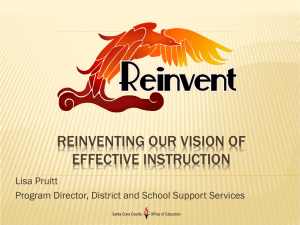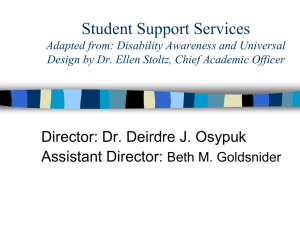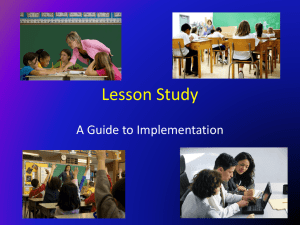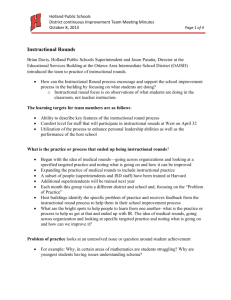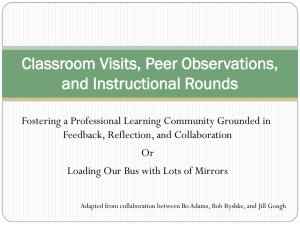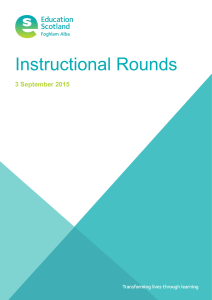Powerpoint - Instructional Supervision by Dr. Lou Matthews
advertisement
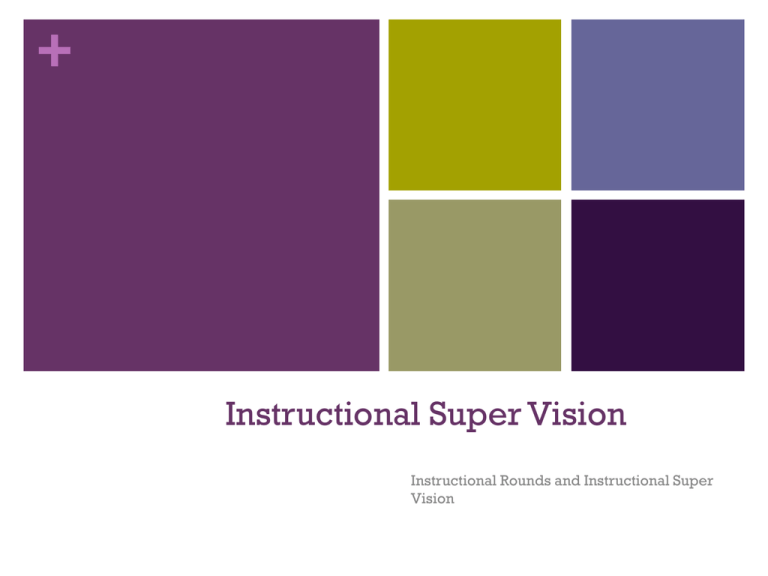
+ Instructional Super Vision Instructional Rounds and Instructional Super Vision + Agenda 1. Mechanisms of Change to Lead Instruction 2. Supervision and Super Vision 3. Instructional Rounds 4. Implications + 3 Key Mechanisms of Change for Quality Instruction A Super Vision of excellent teaching in mathematics, language arts, science, etc…. Wisdom of Practice of Exemplary Teachers in the Building Locally agreed upon; discussed; shared between all in school Worst kept secret in the building; Do teachers who represent exemplary practice in your school guide the shift in teaching at your school? – In many schools, they don’t Instructional Rounds A way of seeing, discussing, analyzing and engineering for excelent teaching Quality of a sample of lessons in primary and middle schools - 2007 25 Number of lessons + 4 20 15 Primary Middle 10 5 0 Inadequate Satisfactory Good Outstanding + Features of inadequate lessons – Bermuda Education Review An M1 class that was crayoning and cutting out (!) photocopied pictures to make a history timeline on a predetermined template; An S4 marine biology class that was superficially describing (rather than classifying) a range of marine artefacts, working in small groups, without either clear purpose or the precise observation that sketching would have entailed; A P6 class which was ‘calculating’ areas of simple two-dimensional geometrical shapes by counting the squares on squared paper; An M2 social studies class considering early Bermudian visitors, into which bored students drifted in and out, and copied information from the board in poor handwriting into unmarked exercise books. 5 + Instructional Rounds Mechanism of Change for High Quality Teaching Inadequate lessons could and should be virtually eliminated by principals and their deputies through keeping more closely in touch with the quality of day+ to-day learning in their classrooms. - 2007 Bermuda Education Review + Instructional Rounds Problem of Practice The Next Work Instructional Rounds Conversation and Engagement Observation of Practice + 1. Problem of Practice Focuses on the instructional core; is directly observable; is actionable (is within the school/district’s control and can be improved in real time); connects to a broader strategy of improvement (school, system). Network adopts the problem of practice as the focus for the network’s learning. + 2. Observation of Practice descriptive not evaluative; specific; about the instructional core; related to the problem of practice. + + + + 3. Debrief on Practice Describe what you saw. Analyze the descriptive evidence (What patterns do you see? How might you group the data?) Predict what students are learning. If you were a student in this class/ school and you did everything the teacher told you to do, what would you know and be able to do? + 4. Next Work Share system context, including resources, professional development, and current initiatives. Brainstorm the next level of work for this week/next month/by the end of the year. Brainstorm suggestions for school level and for system level. Tie suggestions to the district’s (and school’s) improvement plan + How We Describe? What are Teachers Doing and Saying? What are Students Doing and Saying? What is the Task + Judgemental or Non Judgemental Where our descriptions with or without judgement? How would you lead off a conversation? + Description Includes Observer’s Judgment Fast-paced Too much time on discussion, not enough time on individual work. Excellent classroom management Teacher used effective questioning techniques with a range of students Teacher read from a book that was not at the appropriate level for the class Teacher had a good rapport with students Students conducted a very sophisticated lab experiment Description Without Judgment •Teacher asks, “How did you figure out this problem?” Student explains •Students followed directions in the text to make circuit boards. •Teacher said, “Write the words that I spell in the blank spaces. S-P-O-T. D-O-T. P-O-T.” •Task: Find different ways to create a total of 31. Student 1 wrote in math journal: 5+5+5+5+5+5+1 = 31 10+10+10+1= 31 S2: 20+9=03 S3: 41 -1- = 31 2+3X3+16= 31 • Student 1 asks student 2: “What are we supposed to write down?” Student 2: “I don’t know.” + Implications for Principals and Their Work Having in place a school vision for quality instruction “Seeing” Instruction is an ingrained part of teacher and principal habits Feedback and professional conversations are supported for individuals and school Formal documentation is completed and accurate




